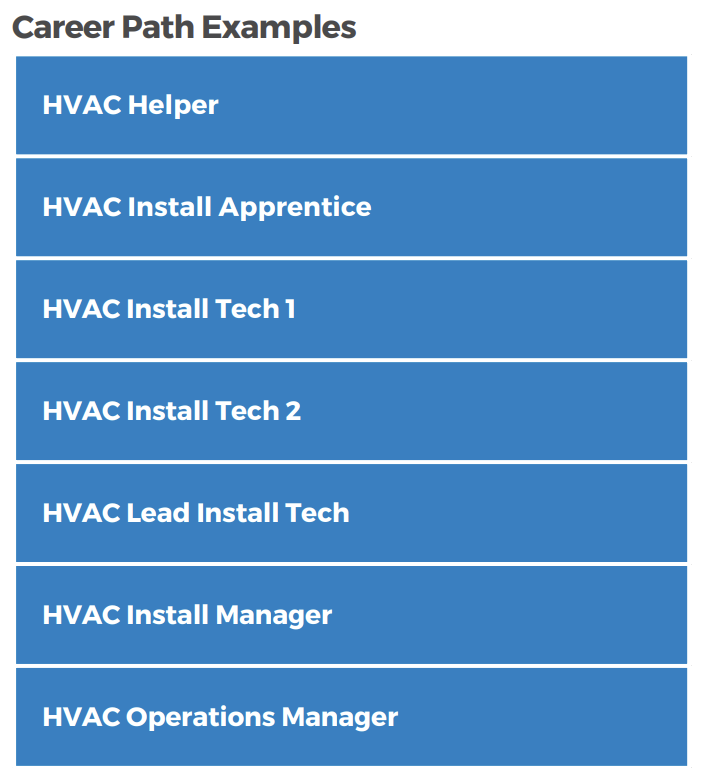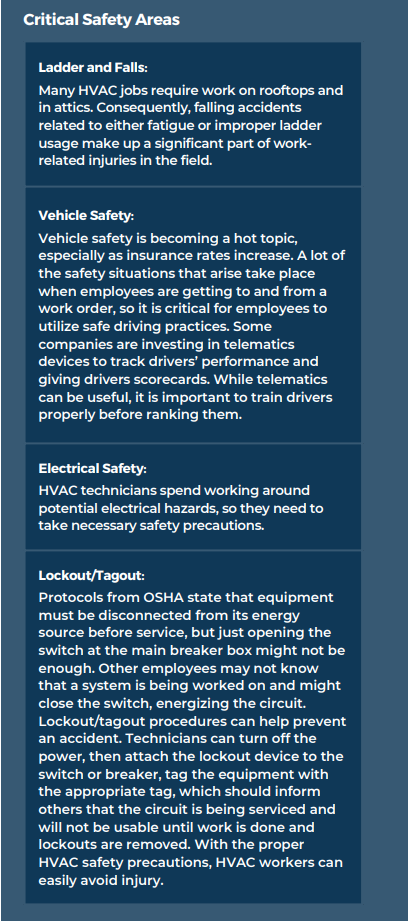Four HVAC Trends Impacting the Industry: Let Training Keep You Ahead of the Curve
Let Training Keep You Ahead of the Curve
The HVAC industry is being pushed and pulled in many directions – from new and evolving technology to increased demands for efficiency. To keep up, businesses must stay on top of shifting regulatory requirements while also continuing to meet workers’ expectations. At the same time, this field is in the middle of a healthy growth spurt.
The Bureau of Labor Statistics projects that by 2031, the field will experience a 5% increase in job growth and there will be more than 40,000 openings for mechanics and installers each year, on average, over the decade. Skilled HVAC employees are in demand, and many companies have difficulty filling open positions.
The HVAC industry is facing a mix of challenges and opportunities. Training has always been an essential part, but it’s now taking on even greater significance as companies work to keep up with several industry trends.
In this paper, we’ll discuss the top four HVAC trends, applying to both residential and commercial spaces, that you should address to maintain your competitive advantage.
Keeping up with Key HVAC Trends
1. Changes in Equipment
Technical innovations in the HVAC space are evolving quickly, and manufacturers are introducing systems that offer better efficiency, less energy consumption and reduced emissions. OEMs are increasingly rolling out smart HVAC systems with sensors that can communicate with each other, creating additional energy-saving capabilities, convenience and complexity.
States and the federal government are addressing climate change by focusing on refrigerants. As a result, many of the changes are driven by new regulatory requirements. New minimum efficiency standards are taking effect, and seasonal energy efficiency ratio (SEER) ratings for AC units and heat pumps will increase from 13 to 14 in northern states and 14 to 15 SEER in the South and Southwest regions of the country. As a result, your technicians must be well-versed in changing minimum efficiency standards and the rules within their service areas.
The U.S. Environmental Protection Agency has been given statutory authority to move forward with phasing down hydrofluorocarbons as part of the American Innovation and Manufacturing Act (AIM), which has impacted the refrigerant industry. The industry is seeing increased adoption of new refrigerants and low-charge and packaged systems as companies work to meet regulatory requirements while improving sustainability and safety.
Even without regulatory requirements, consumers, employees, boards and other stakeholders are concerned about sustainability, leading manufacturers to develop more energy-efficient solutions and customers to ask for the latest technology to boost efficiency.
As manufacturers develop and businesses adopt new and innovative mechanical and automation systems, you and your employees must stay ahead of the curve. Thorough brand-agnostic training gives your technicians a good base of knowledge, which you can supplement with manufacturer-specific information.
2. A Worsening Labor Shortage
Nearly all industries, no matter the skill level needed, are experiencing a worker shortage. Still, occupations and industries that require specialized skills and training have even more vacancies. Labor market data show a clear and steady need for more trades workers over the next decade, with 1.3 million job openings annually through 2028.
As workers continue to age out of the skilled trades, fewer people enter the field, and the problem is expected to worsen. Currently, 40% of the 12 million people in the skilled trades workforce are over the age of 45, with nearly half of those workers over 55, and less than 9% of workers aged 19-24 are entering the trades.
There are too many open jobs and not enough workers to fill them, which means finding workers with the right skills is getting harder. That makes it critical to switch your recruiting style to “hire for attitude, train for aptitude,” which expands your potential labor pool. More importantly, by investing in training and career development and creating a culture of ongoing education, you’ll give yourself a competitive edge by becoming an employer of choice.
While bringing on new talent is often a priority when meeting labor challenges, one overlooked talent pool is your current staff. By investing in existing workers through upskilling and cross-training initiatives, your current workforce can develop the skills necessary to perform the jobs you need them to do now while also preparing them for future demands. Many experienced workers value opportunities to improve their skills to keep up with new technology.
Currently, 40% of the 12 million people in the skilled trades workforce are over the age of 45, with nearly half of those workers over 55, and less than 9% of workers aged 19-24 are entering the trades.
3. Increased Demand for Clear Career Paths
As experienced Baby Boomers are retiring, you need to attract younger workers, and employees increasingly want to see clear pathways for growth and guidance and mentorship from their employers.
Using career ladders—the progression of jobs in an organization based on level of responsibility and skills— gives employees an ongoing mechanism to enhance their skills and knowledge, master their current job and receive promotions.
A career development path also directly impacts your entire organization by improving morale, increasing productivity and boosting retention. Employees are generally more engaged when they believe their employer is concerned about their growth and provides avenues to reach individual career goals while fulfilling the company’s mission.

In a study by the global staffing firm Randstad, 73% of employers said fostering employee development is essential. Generation Y workers—those born between 1981 and 1996—are the least likely to be interested in pay increases and most likely to be interested in learning new skills. They are also more likely to value a career path than any other generation.
The HVAC industry lends itself well to career ladders. Many companies are breaking their job descriptions down into more roles with defined skill sets and establishing a clear path for employees to ladder up based on their skill level rather than years of experience.
Employees who are engaged are more likely to stay with their employer. A study by the University of Phoenix found that 65% of employees said they would be more likely to stay with the same company throughout their careers if their employer did more to reskill them. That number is even higher for Millennials (74%) and Gen Zers (71%). Even if they don’t stay throughout their entire career, 68% of employees said they would be more likely to remain at their company if an emphasis was placed on upskilling and reskilling. That number jumps to 74% for Gen Zers and 77% for Millennials.
65% of employees said they would be more likely to stay with the same company throughout their careers if their employer did more to reskill them.
4. A Call for Safety
More and more contractors are emphasizing the importance of safety and are investing time, effort and resources in training their workforce to do their jobs safely and efficiently.
Improved safety decreases costs, increases employee productivity, and improves recruitment and retention. A survey of small business employees conducted by an insurance company found that workplace safety was among the top criteria employees consider when evaluating a new job offer. Plus, OSHA has been stepping up its prosecution of safety standard violations.
Safety training is vital for new entrants into the field as well as long-time employees, who can sometimes get complacent with safety protocols. Safety training also ensures workers are complying with all federal and state safety standards.
Risk can vary based on the part of a building or the piece of equipment or machinery a contractor is working on, and workers need to understand potential hazards to address them. From electrical hazards and combustible gasses to difficult environments, there are major risks that come with HVAC work. HVAC, by the numbers, is safer than carpentry, electrical work or roofing, but it’s still important to recognize potential dangers and know how to keep safe on the job.

Making Training Engaging
While technology is transforming the HVAC
industry, it is also bringing significant changes to
training offerings. The rapid adoption of virtual
reality (VR) technology and online 3D simulations
creates an immersive, hands-on learning
experience, increasing training effectiveness and
making it more engaging for employees.
Research examining virtual reality’s effectiveness
has found that it reduces the time to learn,
decreases the number of trainee errors, increases
the amount learned, and helps students retain
knowledge longer than traditional methods.
VR and AR have been proven to improve the
learning process. Typically, students remember
30% of what they hear and 20% of what they see,
but they retain 90% of the material if it is learned
through experience. A study at the University of
California, Los Angeles found that medical
students who learned with VR completed an
orthopedic procedure 20% faster, on average, than
those in the traditionally trained group. They
finished 38% more steps correctly in the
procedure-specific checklist.
The PwC 2022 U.S. Metaverse Survey found VR is keeping learners’ attention. There are no interruptions and no options to multitask, and VRtrained employees were up to four times more focused during training than their e-learning peers and 1.5 times more focused than their classroom colleagues. More importantly, learners felt 275%
more confident applying skills after training.
VR and 3D simulations on a desktop or laptop are
also helpful in situations where safety is a concern
and can provide effective training in a risk-free,
cost-effective environment, giving students a safe
place to make mistakes and gain job-ready skills
before entering the workforce
Preparing for Success
Technology innovations, government regulations and sustainability initiatives don’t show any signs of slowing down, nor do the labor challenges facing the skilled trades. Given the ever-evolving nature of the HVAC industry, one of the best things your company can do is keep up with emerging trends so you understand your customers’ needs well before they do and prepare your employees to meet new demands. Well-trained staff are essential to taking advantage of new opportunities. Effective training also helps you attract, retain and develop employees. Embracing a culture of learning and adopting new ways of doing business can only add to your long-term success.
About Interplay Learning
Interplay Learning offers online and virtual reality training for the skilled trades, including HVAC, plumbing, electrical, solar, multifamily maintenance and facilities maintenance, that is scalable and effective. Using immersive technology, learners can train and practice hands-on learning from a desktop, phone, tablet or in virtual reality. Users can access 300+ hours of online expert-led courses and hands-on simulations to supplement existing training and help technicians learn skilled trades.
